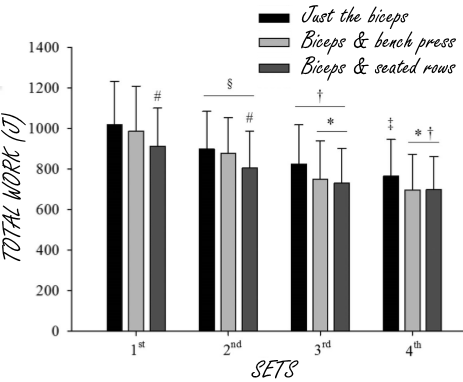- Joined
- Aug 20, 2013
- Messages
- 27,119
- Reaction score
- 17,678
- Points
- 113
First train your back, then your biceps? Better not, says study
If you have a bit of experience with strength training, then you have experienced it yourself for a long time. But because it is always nice to see experiential knowledge confirmed in scientific research, we are just writing a piece about the study that Brazilian scientists published in December 2017 in the Journal of Strength & Conditioning Research. According to that research, you should not train your biceps if you have just trained your back. Training biceps after you have trained the chest is better.
Study
The 15 test subjects - students who on average had some two years of experience with strength training - trained their biceps on 3 different occasions with 4 sets on a Scott machine. Sometimes the test subjects only trained their biceps; the second time they first did 4 sets of bench presses and only then trained their biceps; the third time they only trained their biceps after they had first finished 4 sets for their upper back muscle on a seated-row machine.
Results
Whether the researchers looked at the strength [actually: the torque ] that the test subjects could develop, or the amount of work they could do [expressed in joules], the most effective bicep training was the workout in which the students trained their biceps, and nothing else.
Secondly, the researchers discovered that the biceps training in which the students first bench press and then started training their biceps was more effective than the workout in which the students first trained their backs, and then their biceps.
The figure below refers to the amount of joules produced during bicep training. The figures for torque and electrical activity in the muscles [EMG] [say: how strongly the training stimulated the biceps] were not essentially different.

Conclusion
" The main purpose of the split training system is to maximize training volume within a training session and to allow appropriate muscle recovery, " the researchers summarize. " Our results showed that the force production, volume, and recovery were greater when the elbow fl exors muscle group was exercised alone during the training session ."
" In addition, the non-synergist condition presented greater force production, volume, and recovery when compared to the synergist condition ."
" Thus, the results of the present study suggest that strength and conditioning professionals, when applying the split training system, should target only one muscle group in each session or consider using the non-synergist training routine (ie, chest exercise before elbow fl exors exercise or back before elbow extensor exercise) in resistance-trained subjects . "
Source:
J Strength Cond Res. 2017 Dec; 31 (12): 3482-8.
If you have a bit of experience with strength training, then you have experienced it yourself for a long time. But because it is always nice to see experiential knowledge confirmed in scientific research, we are just writing a piece about the study that Brazilian scientists published in December 2017 in the Journal of Strength & Conditioning Research. According to that research, you should not train your biceps if you have just trained your back. Training biceps after you have trained the chest is better.
Study
The 15 test subjects - students who on average had some two years of experience with strength training - trained their biceps on 3 different occasions with 4 sets on a Scott machine. Sometimes the test subjects only trained their biceps; the second time they first did 4 sets of bench presses and only then trained their biceps; the third time they only trained their biceps after they had first finished 4 sets for their upper back muscle on a seated-row machine.
Results
Whether the researchers looked at the strength [actually: the torque ] that the test subjects could develop, or the amount of work they could do [expressed in joules], the most effective bicep training was the workout in which the students trained their biceps, and nothing else.
Secondly, the researchers discovered that the biceps training in which the students first bench press and then started training their biceps was more effective than the workout in which the students first trained their backs, and then their biceps.
The figure below refers to the amount of joules produced during bicep training. The figures for torque and electrical activity in the muscles [EMG] [say: how strongly the training stimulated the biceps] were not essentially different.

Conclusion
" The main purpose of the split training system is to maximize training volume within a training session and to allow appropriate muscle recovery, " the researchers summarize. " Our results showed that the force production, volume, and recovery were greater when the elbow fl exors muscle group was exercised alone during the training session ."
" In addition, the non-synergist condition presented greater force production, volume, and recovery when compared to the synergist condition ."
" Thus, the results of the present study suggest that strength and conditioning professionals, when applying the split training system, should target only one muscle group in each session or consider using the non-synergist training routine (ie, chest exercise before elbow fl exors exercise or back before elbow extensor exercise) in resistance-trained subjects . "
Source:
J Strength Cond Res. 2017 Dec; 31 (12): 3482-8.


